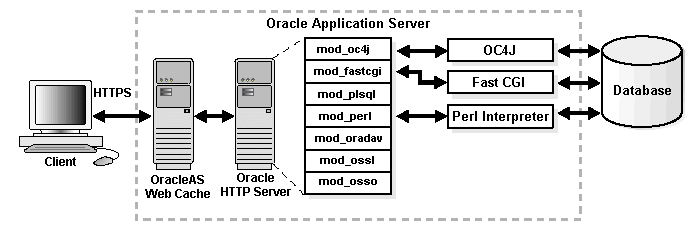10g (9.0.4)
Part Number B10381-01
Home |
Solution Area |
Contents |
Index |
| Oracle HTTP Server Administrator's Guide 10g (9.0.4) Part Number B10381-01 |
|
This chapter describes the Oracle HTTP Server, highlighting the differences between the Oracle distribution and the open source Apache product on which it is based. It also explains how to start, stop and restart the server.
Topics discussed are:
Documentation from the Apache Software Foundation is referenced when applicable.
Oracle HTTP Server is the Web server component of Oracle Application Server. It is based on the Apache HTTP Server, version 1.3.28. It is a robust, reliable Web server, pre-configured to do the following:
mod_oprocmgr).
Oracle HTTP Server consists of several components that run within the same process. These components provide the extensive list of features that Oracle HTTP Server offers when handling client requests. Following are the major components:
"Oracle HTTP Server Modules" for a complete list of modules shipped with Oracle HTTP Server.
See Also:
Figure 1-1 shows the path of various requests through Oracle HTTP Server components, where a client machine connects to Oracle Application Server Web Cache, which in turn connects to Oracle HTTP Server. Oracle HTTP Server, using various modules, connects to the database through OC4J, FastCGI, or the Perl interpreter.

|
See Also:
Oracle Application Server 10g Concepts for more information regarding Oracle Application Server components, and how they relate to each other. |
Table 1-1 identifies the modules shipped with Oracle HTTP Server. Modules extend the basic functionality of the Web server, and support integration between Oracle HTTP Server and other Oracle Application Server components. Note that the list differs from the Apache open source distribution (given the inclusion of Oracle modules), and that not all modules are supported by Oracle.
Oracle provides technical support for the following Oracle HTTP Server features and conditions:
Oracle HTTP Server can be managed using the following two methods:
You can manage Oracle HTTP Server using Oracle Enterprise Manager. Oracle Enterprise Manager enables you to manage your server from a Web browser using Oracle Enterprise Manager Application Server Control (Application Server Control).
|
See Also:
|
You can use also the following command-line tools to manage Oracle HTTP Server:
Provides a command-line utility for Oracle Process Manager and Notification Server (OPMN) for process management. It is located in
ORACLE_HOME/opmn/bin
ORACLE_HOME\opmn\bin
Oracle Process Manager and Notification Server Administrator's Guide for more information on
See Also:
opmnctl.
Provides a command-line utility for Distributed Configuration Management (DCM) for configuration management and application deployment. It is located in
ORACLE_HOME/dcm/bin
ORACLE_HOME\dcm\bin
Distributed Configuration Management Reference Guide for more information on
See Also:
dcmctl.
You must use the DCM utility dcmctl in circumstances such as:
Distributed Configuration Management Reference Guide for detailed information regarding
See Also:
dcmctl and the commands required to perform the above mentioned tasks.
Oracle HTTP Server is managed by Oracle Process Manager and Notification Server (OPMN). You can use Oracle Enterprise Manager Application Server Control to start, stop, and restart the server.
For command-line management, you can use the opmnctl utility to start, stop, and restart the server.
You must always use OPMN to start, stop and restart Oracle HTTP Server. Otherwise, the configuration management infrastructure cannot detect or communicate with the Oracle HTTP Server processes, and problems may occur.
To determine the state of Oracle HTTP Server, use the following command:
opmnctl status
The processes are listed with their current state (Up, Down, etc.)
To start Oracle HTTP Server, use the startproc command:
ORACLE_HOME/opmn/bin> opmnctl [verbose] startproc ias-component=HTTP_Server
ORACLE_HOME\opmn\bin> opmnctl [verbose] startproc ias-component=HTTP_Server
To stop Oracle HTTP Server, use the stopproc command:
ORACLE_HOME/opmn/bin> opmnctl [verbose] stopproc ias-component=HTTP_Server
ORACLE_HOME\opmn\bin> opmnctl [verbose] stopproc ias-component=HTTP_Server
Restarting Oracle HTTP Server performs a graceful restart, which is invisible to clients. In a graceful restart, on UNIX, a USR1 signal is sent. When the process receives this signal, it tells the children to exit after processing the current request. (Children that are not servicing requests exit immediately.)
The parent re-reads the configuration files and re-opens the log files, replacing the children with new children in accordance with the settings it finds when re-reading the configuration files. It always observes the process creation settings (MaxClients, MaxSpareServers, MinSpareServers) specified, and takes the current server load into account.
To restart Oracle HTTP Server, use the restartproc command:
ORACLE_HOME/opmn/bin> opmnctl [verbose] restartproc ias-component=HTTP_Server
ORACLE_HOME\opmn\bin> opmnctl [verbose] restartproc ias-component=HTTP_Server
Oracle Process Manager and Notification Server Administrator's Guide for more information on
See Also:
opmnctl command options.
|
|
 Copyright © 2002, 2003 Oracle Corporation. All Rights Reserved. |
|